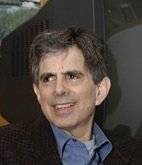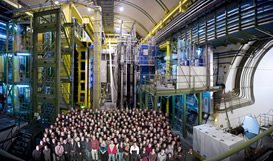SU scientists assist in landmark discovery of rare particle decay
Finding declared a 'victory' for Standard Model of physics

Physicists in Syracuse University’s College of Arts and Sciences are part of a global team of scientists who has discovered a rare particle decay, giving them an indirect way to test models of new physics.
Fifteen SU researchers, led by Distinguished Professor of Physics Sheldon Stone, have been working at CERN, the world’s leading laboratory for particle physics, headquartered in Geneva, Switzerland. There, they have been involved with the Large Hadron Collider beauty (LHCb) experiment, which seeks to identify new forces and particles, in addition to those already known and codified in the Standard Model, a theory which describes the physical makeup of the universe.
Stone and his colleagues have found evidence of particle decay made up of two kinds of quarks—bottom quarks and anti-strange quarks—that, in turn, form a pair of particles called muons.
A quark is a fundamental constituent of matter. A muon is a heavy electron.
“The Standard Model predicts rather accurately that, out of a billion [particle] decays, there will be three where the quark-anti-quark pair transforms into a positive and negative muon,” says Stone. “The LHCb experiment has done this and has seen strong evidence for this decay, albeit at a rate predicted by the Standard Model. Small deviations from the predicted rate would firmly establish the presence of new forces or particles."
That another LHC experiment—the Compact Muon Solenoid, or CMS—has produced similar results at CERN suggests the particle decay discovery is real.
Although physicists call the finding a “victory for the Standard Model,” they are quick to point out that the model is far from complete. In fact, Stone and his colleagues are eager to collect more data to see if small deviations from model predictions actually appear—clear indicators of new physics. “We keep trying to find things that disagree with it,” says Joel Butler, a physicist at Fermilab, a national laboratory in Illinois that specializes in high-energy particle physics.
"This latest measurement sets important new guidelines for theories of matter,” says A. Alan Middleton, professor and chair of physics at SU. “The Syracuse group is already planning the next generation of technology, which will be built here and shipped to Switzerland to help solve these problems."

Since heavy particles are unstable and decay almost immediately, Stone and his colleagues have been searching for viable evidence of particle decay products, rather than the particle itself. In 2010, his team developed a special technique for measuring B meson yields, which has since been used by other LHC experiments.
“Fourteen billion years ago, the universe began with a bang, and matter and anti-matter were formed,” says Stone. “But just one second after the Big Bang, anti-matter all but disappeared. …The LHCb experiment is designed to find out what really happened after the Big Bang that has allowed matter to survive and build the universe we inhabit today.”
Housed in The College, the Department of Physics has been educating students and carrying out research for more than 125 years. Graduate and undergraduate opportunities are available in fields ranging from biological and condensed matter physics, to cosmology and particle physics, to gravitational wave detection and astrophysics.
Media Contact
Rob Enslin
